A group of scrappy young baseball players become celebrated athletes who win respect at a national championship in Wei Te-sheng’s (魏德聖) Kano. But Wei’s film, which is based on a true story, is more than just a movie about baseball.
As with his earlier Cape No. 7 (海角七號, 2008) and Warriors of the Rainbow: Seediq Bale (賽德克.巴萊, 2011), Wei’s latest film presents a version of history not commonly taught in Taiwan’s schools but remains an integral part of the nation’s identity.
Whereas Cape No. 7 examined the relationship between Taiwan and Japan through parallel stories that span 60 years and Warriors of the Rainbow dramatized the 1930 Wushe Incident (霧社事件), Kano tells the story of a high-school baseball team from Chiayi that takes second-place in Japan’s prestigious national high school baseball championship at Hanshin Koshien Stadium in 1931. It offers an uplifting perspective on Taiwan’s history, culture and identity through the game of baseball, which was introduced by Japan.
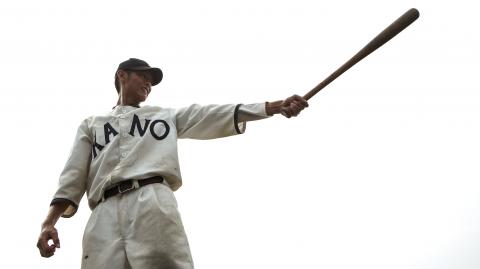
Photo courtesy of Vie Vision Pictures
The film opens in Keelung, 1944, where soldiers of the Japanese imperial army are preparing to depart for the Southeast Asian theater of War World II. We follow a group of officers boarding a crowded train that’s making its way to the southern tip of the Taiwan. Settling down into a seat, Joshiya (Aoki Ken) tells one of his fellow soldiers to “wake me up in Chiayi.” The former baseball player wants to see the birthplace of Kano (嘉農), the nickname of the Chiayi high school baseball team that he had played against in the legendary tournament.
We then travel back to 1929, when Japanese, Taiwanese and Aboriginal high school ballplayers are rigorously training under the eye of their coach Kondo (Masatoshi Nagase) in the lush fields of Chiayi. While others were dismissive of the team’s prospects because they’d never won a game, the coach encourages the young athletes to train hard so as to compete at the Koshien championship.
And against all odds they do. In 1931, after winning Taiwan’s regional tournament, the previously obscure team travels to Japan and stuns its rivals at Koshien. Among them, Joshiya, a star athlete and the Hokkaido team’s pitcher, is overwhelmed by the team’s stamina and admits defeat.
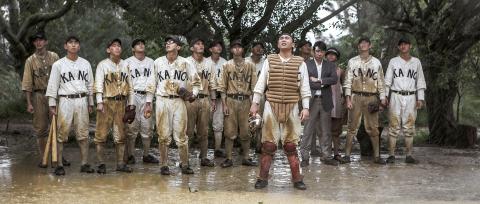
Photo courtesy of Vie Vision Pictures
Kano eventually advances to the finals, but the fierce game takes its toll on Go (Tsao Yu-ning, 曹佑寧), the team’s pitcher, who has suffered an injury to his hands that makes it difficult to pitch. Despite the painful injury, Go persists. And so do his teammates, banding together to fight until the end.
Kano, however, eventually loses the game. But as the players leave the stadium, the 55,000 baseball fans who attended the championship give the team a standing ovation, marking a monumental moment in the history of baseball in Taiwan.
A feature debut by Umin Boya, an actor and director of Sediq (賽德克) and Sakizaya (撒奇萊雅) descent who starred in Wei’s Warriors of the Rainbow: Seediq Bale, the technically polished film is an audio-visual feast designed to elicit big emotions. The opulent cinematography of Chin Ting-chang (秦鼎昌), Wei’s long-time collaborator, transforms a sleepy backwater town into a charming pastoral heaven. Meticulous research is evident in the great amount of historically accurate props, costume and large-scale settings which include the streets of 1930s Chiayi and the Hanshin Koshien Stadium.
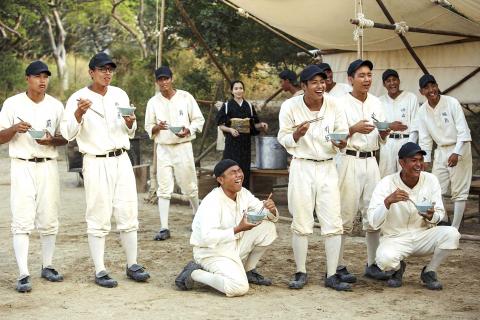
Photo courtesy of Vie Vision
As may be expected with a sports film, the narrative climax is achieved in the game’s final matches, where real-life baseball players have been used to great effect. The cast of young professional athletes inject striking energy and gripping tension into the sequences, and the director also deserves applause for successfully delivering the tactics and emotional elements that make the game of baseball so enthralling.
Taiwan’s colonial past is ever present in the story and its portrayal is surprisingly upbeat. Whereas Warriors of the Rainbow: Seediq Bale shows tribal chief Mouna Rudo leading Seediq warriors in a violent uprising against their Japanese oppressors, Kano depicts Japanese, Taiwanese and Aborigines uniting for a cause. Most of the first half of film is dedicated to portraying the harmonious coexistence between Taiwanese and Japanese, who together build Taiwan’s colonial infrastructure.
However, instead of exploring in psychological depth the lives of the different ethnic communities, the movie at times resembles a work of propaganda — expressed by the character Hatta waving to the Taiwanese farmers with a toothsome smile — and relies too much on composer Naoki Sato’s overwrought score which appears designed to sway emotions rather than set a mood.
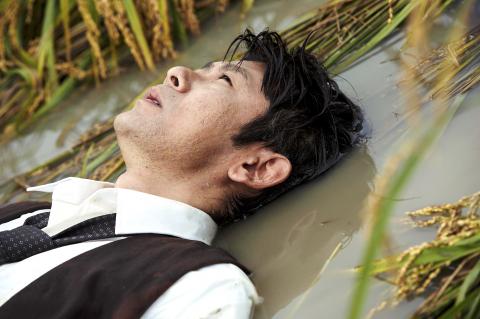
Photo courtesy of Vie Vision
Still, Kano forms the third in a trilogy of movies where Wei and his filmmaking colleagues have created a cinematic world that looks at Taiwan’s colonial past through different viewpoints, while inviting Taiwanese audiences to rethink their history.
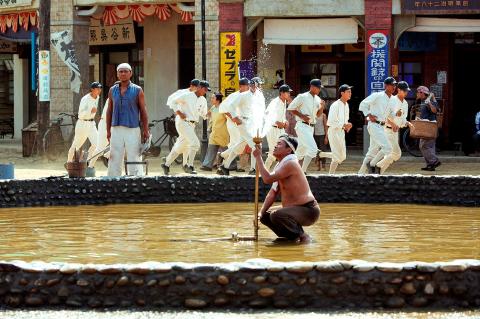
Photo courtesy of Vie Vision

May 11 to May 18 The original Taichung Railway Station was long thought to have been completely razed. Opening on May 15, 1905, the one-story wooden structure soon outgrew its purpose and was replaced in 1917 by a grandiose, Western-style station. During construction on the third-generation station in 2017, workers discovered the service pit for the original station’s locomotive depot. A year later, a small wooden building on site was determined by historians to be the first stationmaster’s office, built around 1908. With these findings, the Taichung Railway Station Cultural Park now boasts that it has

The latest Formosa poll released at the end of last month shows confidence in President William Lai (賴清德) plunged 8.1 percent, while satisfaction with the Lai administration fared worse with a drop of 8.5 percent. Those lacking confidence in Lai jumped by 6 percent and dissatisfaction in his administration spiked up 6.7 percent. Confidence in Lai is still strong at 48.6 percent, compared to 43 percent lacking confidence — but this is his worst result overall since he took office. For the first time, dissatisfaction with his administration surpassed satisfaction, 47.3 to 47.1 percent. Though statistically a tie, for most

Six weeks before I embarked on a research mission in Kyoto, I was sitting alone at a bar counter in Melbourne. Next to me, a woman was bragging loudly to a friend: She, too, was heading to Kyoto, I quickly discerned. Except her trip was in four months. And she’d just pulled an all-nighter booking restaurant reservations. As I snooped on the conversation, I broke out in a sweat, panicking because I’d yet to secure a single table. Then I remembered: Eating well in Japan is absolutely not something to lose sleep over. It’s true that the best-known institutions book up faster

In February of this year the Taipei Times reported on the visit of Lienchiang County Commissioner Wang Chung-ming (王忠銘) of the Chinese Nationalist Party (KMT) and a delegation to a lantern festival in Fuzhou’s Mawei District in Fujian Province. “Today, Mawei and Matsu jointly marked the lantern festival,” Wang was quoted as saying, adding that both sides “being of one people,” is a cause for joy. Wang was passing around a common claim of officials of the People’s Republic of China (PRC) and the PRC’s allies and supporters in Taiwan — KMT and the Taiwan People’s Party — and elsewhere: Taiwan and